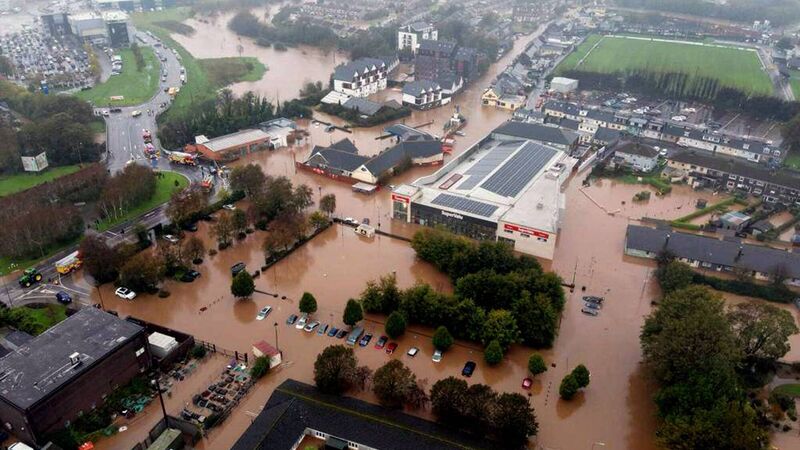Why early-warning systems matter more than ever

Catastrophic flooding in Midleton with drone footage showing the scale of the floods during Storm Babet in 2023. Picture: Guileen Coastguard
The best early-warning systems all do the same simple thing — they buy us time. Time to move a car, lift stock, protect a home, or in the most serious cases, get out of the way. Whether it’s a river quietly rising or a storm rolling in from the Atlantic, the power of an early-warning system lies not in predicting the future perfectly, but in giving people a head start.
What makes a good system work is straightforward. It must detect danger early, communicate clearly, and prompt effective action. It is a chain with no weak links. You need reliable observations, a way to interpret them, and a community that trusts the information enough to respond. When all of that lines up, early alerts can dramatically reduce damage... even if the hazard itself can’t be stopped.
This idea isn’t new. Long before sensors and satellites, people used whatever tools they had to read the world around them. In fact, the earliest warning systems were rooted in observation, culture and instinct.
- Centuries ago, many Pacific Island communities read the ocean like a living map. A change in swell direction or rhythm signalled storms thousands of kilometres away.
- Mountaintop beacon towers in ancient China relayed warnings of invasion through chains of smoke and fire — an early form of real-time communication.
- Farmers across Europe knew that swallows flying low meant falling pressure and incoming rain.
- In polar and mountain regions, the sharp crack of shifting ice warned herders to move livestock before glaciers or avalanches released their force.
None of these systems required instruments; they were based on careful, generational observation. Primitive perhaps, but surprisingly accurate. They captured a principle that still guides modern warning systems, where nature gives clues if you know how to recognise them.
As science advanced, so did our warnings. The 19th-century telegraph revolutionised storm forecasting, letting coastal stations share weather observations instantly. Networks of river gauges, tide sensors and barometers emerged, gradually forming the backbone of official meteorological services.
Today, early warning systems span Earth and ocean. Satellites track storm development from orbit. Radar maps rainfall with minute-by-minute precision. Deep-ocean buoys detect the faint pressure changes that precede tsunamis. Computer models simulate future conditions before they unfold.
And increasingly, artificial intelligence spots patterns that humans might overlook, learning from past events to anticipate new ones.
Yet the purpose remains exactly the same as it was for farmers watching swallows, which is to see trouble early enough to act.
Flooding is where early warning systems prove their worth most dramatically. Rivers rarely burst without offering hints; heavy upstream rainfall, high tides, saturated soils, rising gauges. The trick is processing those clues quickly and sending them to the right people at the right moment.
In a warming Ireland, the need for robust flood warnings is growing. A warmer atmosphere holds more moisture, making extreme rainfall more frequent and more intense. That, combined with urbanisation and overloaded drainage systems, means communities need every advantage they can get.
After catastrophic floods in 2023, when the Owenacurra River surged through homes and businesses, Midleton found itself urgently seeking better protection. National forecasts were helpful, but too broad. Physical flood defences were years away. What the town needed was something immediate and local, and something that could react to its river in real time.
Earlier this year, a flood warning system built around a series of river-level sensors was introduced in Midleton.
These sensors track water height along the river and feed continuous data into an algorithm trained to recognise worrying patterns; rapid rises, unusual behaviour, or combinations of conditions that have historically led to flooding. When thresholds are crossed, the system sends automatic text alerts to thousands of residents.

During recent heavy rainfall, it correctly identified that while water levels were high, the river was rising slowly rather than suddenly... a nuance that matters hugely to people deciding whether to take action. It kept residents alert but not alarmed — a sign of a system doing exactly what it should.
It’s not a replacement for national forecasting or engineered flood defences, but it fills a crucial gap. It gives Midleton what every community facing climate-driven extremes needs… more time.
For all their technology, early warning systems still hinge on people. A perfectly accurate alert is useless if no one receives it, or if residents are unsure what to do. Clear communication, trust in the system and simple, actionable steps are what turn information into outcomes.
Warnings must be delivered neither too often nor too rarely. Too many alerts and people begin to ignore them. Too few and they may be caught off guard. When the balance is right, early warnings quietly save lives and livelihoods, often without anyone realising just how close a call it was.
Ireland’s climate is shifting, and with it comes a need to adapt fast. Early warning systems offer one of the most cost-effective, immediate and life-preserving forms of climate resilience available. They don’t stop storms. They don’t hold rivers back. But they create space for action, and that space can make all the difference.
From the flight of swallows to the flicker of beacon fires, from telegraphs to AI-powered river sensors, the tools may have changed, but the goal remains unchanged; to spot danger early, so we can stay one step ahead of it.

Midleton’s new system is just one example of how communities can pair innovation with preparedness. In a wetter, more unpredictable world, learning to listen to data as much as to nature, may be the strongest defence we have.
Check out the Irish Examiner's WEATHER CENTRE for regularly updated short and long range forecasts wherever you are.








